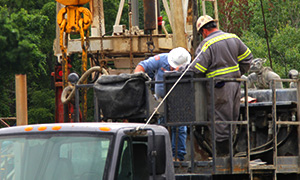As a critical yet complex part of well development, cementing involves highly technical skills and resources. Your cementing contractor is a valuable ally who can ensure the right materials and equipment are on-site when needed.
There are many different factors to consider when it comes to well cementing, and success starts with the basics. This article explains what you should know to start your next cementing project.
The Objectives of Cementing Oil Wells
Cementing is vital to the structural support of a well. As cement is forced up the annulus of a well, it displaces drilling fluid, hardens to hold the casing and shields the steel from corrosion.
When carried out to plan, cementing also provides zonal isolation, preventing fluids from flowing from one subsurface formation to another. Isolation lets an operator exploit a profitable zone without interference, contamination or leaks from surrounding formations.
Finally, at the end of a well’s useful life, contractors use cement to plug a well for safe abandonment.
The procedure for cementing an oil or gas well (known as the “cementing program”) is based on the parameters of the well plan. A well plan includes a range of in-depth information, such as well type, orientation, mud plan, shape, location, completion and more.
Common Cementing Processes
A successful well-cementing program requires precise planning and expert execution for both primary cementing and remedial cementing.
Primary cementing
Cement is pumped at pressure through the casing string to the bottom of the wellbore, where it then pushes upwards and fills the annulus surrounding the casing. Primary cementing is complete when cement freely flows at the well’s surface.
Remedial cementing
A strategic application of cement, remedial cementing can be used to correct problems with the primary cement job, improve production or bring a well to its end of life.
- A Top Job fills space at the top of a well if cement did not reach the surface during primary cementing.
- Squeeze Cementing is used to fill holes and voids or to block off a specific formation.
- Plugging blocks off a well to ensure it is safe to abandon.
At Plants & Goodwin, we specialize in cementing services for the oil and gas industry. We have over 50 years of experience providing rapid, turnkey services and cementing expertise.
The Properties of Well Cement
The American Petroleum Institute describes the appropriate cement classes for different wellbore conditions for oil and gas operations.
Class A&B – For use at shallow well depths; class B is sulfate resistant
Class C – Quick hardening properties
Class D, E&F – For use in deep wells; accommodates high temperatures and pressures
Class G&H – The two most used cement classes for well operations; accepts a wide range of temperatures and pressures. Class G sets faster than Class H.
Additives adjust the properties of a cement slurry. Cement additives can:
- Vary slurry density
- Change compressive strength
- Accelerate or retard setting time
- Control fluid loss
- Adjust slurry viscosity
Some of the most common additives in well cementing include calcium chloride, bentonite, organic polymers and lignosulphonate.
Equipment & Expertise
To support your project, a cementing contractor designs a custom cement blend for specific wellbore conditions based on information such as bottom-hole temperature, formation characteristics, geology and more.
Blend details from your cementing contractor include density, yield, setting time, and the blend’s compressive strength at 24 hours, 48 hours and beyond.
The equipment and supplies for a successful cementing project may include:
Bulk truck – Brings cement ingredients to site. Additives can be pre-mixed or mixed on-site.
Pump truck – Used to pump cement into the well casing. The truck measures the amount of cement used, in either cubic feet, gallons or barrels.
Freshwater – Needed to create the slurry. Water sources may include nearby wells, tanks or a city water supply.
Manifold and mixing tanks – For creating blends and controlling pressure to fulfill the cementing program for your well.
Cementing/circulating head – Installed on top of the wellhead, this device lets the operator maintain pressure and circulation in the hole.
P&G provides a range of reliable equipment, such as:
- Chassis-mounted twin RCM pumps
- Batch mix pumps
- Skid-mounted pumps
- Straight-axle bulk units
- Bulk trailers
Plants & Goodwin has the expertise and equipment to carry out your cementing project successfully. We always put our clients first. As a family-owned business, we’re reliable and ready to help at a moment’s notice.




